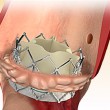TVT STS / ACC registrywas developed to obtain data from all patients undergoing percutaneous aortic valve replacement (TAVR) in the United States. The clinical outcome at 30 days was recently published (Macket al, JAMA 2013) but there are few data on the longer-term treatment that is already incorporated in clinical practice in the United States.The<a href="https://solaci.org/en/2015/06/24/american-registry-for-percutaneous-aortic-valve-replacementone-year-evolution-of-nearly-6000-patients/" title="Read more" >...</a>
The delay between the indication and the embodiment of the procedure decrease the effectiveness of percutaneous aortic valve replacement
Original title: Impact of wait times on the effectiveness of transcatheter aortic-valve replacement (TAVR) in severe aortic valve disease: a discrete event simulation model. Reference: Wijeysundera HC et al. Can J Cardiol. 2014; Epub ahead of print. Once patients are accepted for percutaneous aortic valve replacement (TAVR), the higher the expected for the valve, the greater the risk<a href="https://solaci.org/en/2014/06/17/the-delay-between-the-indication-and-the-embodiment-of-the-procedure-decrease-the-effectiveness-of-percutaneous-aortic-valve-replacement/" title="Read more" >...</a>
Transcatheter valve replacement for bicuspid aortic valve stenosis
Original title: Comparison of Results of Transcatheter Aortic Valve Implantation in Patients with Severely Stenotic Bicuspid versus Tricuspid or Non-Bicuspid Valves. Reference: Charis Costopoulos et al. Am J Cardiol. 2014 Jan 31. pii: S0002-9149(14)00554-2. The bicuspid aortic valve (BAV) is the most common congenital cardiac malformation. It occurs in approximately 1% of the general population and often<a href="https://solaci.org/en/2014/03/11/transcatheter-valve-replacement-for-bicuspid-aortic-valve-stenosis/" title="Read more" >...</a>
The impact of permanent pacemaker implantation in patients undergoing percutaneous aortic valve replacement.
Reference: Buellesfeld y colaboradores (JACC in press). Percutaneous aortic valve replacement (AVR) is an innovative technique for the treatment of severe aortic stenosis (SAS); this technique has been incorporated with great enthusiasm in clinical practice, particularly for patients with excessive surgical risks. Due to the proximity of the aortic valve, AV node and His bundle, there<a href="https://solaci.org/en/2012/10/01/the-impact-of-permanent-pacemaker-implantation-in-patients-undergoing-percutaneous-aortic-valve-replacement/" title="Read more" >...</a>
Aortic Transfemoral Valve Replacement using Edwards SAPIEN and Edwards SAPIEN XT Prosthesis, Local Anesthesia.
Reference: Durand E. et al (JACC CV interventions 2012 in press)1 When percutaneous aortic valve replacement (AVR) first began the procedure required a large-bore sheath (22-24 F), being the most frequent surgical strategy when using general anesthesia. Continuous technological advances achieved the miniaturization of devices which allow the procedure to be performed with a much<a href="https://solaci.org/en/2012/10/01/aortic-transfemoral-valve-replacement-using-edwards-sapien-and-edwards-sapien-xt-prosthesis-local-anesthesia/" title="Read more" >...</a>
2 Year Outcomes of Transcatheter Mitral Valve Replacement with Intrepid
Severe mitral valve insufficiency (MI) has been associated to the progressive deterioration of left ventricular function, cardiac and kidney failure, and increased mortality. Complete medical treatment at maximal doses and surgery are indicated. For those at high risk or those with ventricular function deterioration, edge-to-edge repair has been shown an excellent alternative. The use of<a href="https://solaci.org/en/2024/07/02/2-year-outcomes-of-transcatheter-mitral-valve-replacement-with-intrepid/" title="Read more" >...</a>
Third Generation Balloon-Expandable and Self-Expanding Valves: TAVR Meta- Analysis
TAVR’s significant advance has driven the development of valve technology, which is currently in its third generation. Even though outcomes have improved, randomized studies are yet to compared balloon-expandable (BEV) vs self-expanding (SEV) valves in randomized studies, and we only have information from different analysis with contradicting conclusions. This was a meta-analysis of 16 studies<a href="https://solaci.org/en/2024/05/24/third-generation-balloon-expandable-and-self-expanding-valves-tavr-meta-analysis/" title="Read more" >...</a>
EuroPCR 2024 | Self-Expanding Valves (ACURATE Neo2) vs. Balloon-Expandable Valves (Sapien 3 Ultra): 1-Year Follow-up Results
Comparing different transcatheter heart valves (THVs) is necessary to obtain relevant information that facilitates the selection of the appropriate valve for each patient. A previous study compared early outcomes between the self-expanding ACURATE Neo2 valve and the balloon-expandable Sapien 3 Ultra valve. However, there are no comparative data on these two valves in the medium<a href="https://solaci.org/en/2024/05/22/europcr-2024-self-expanding-valves-acurate-neo2-vs-balloon-expandable-valves-sapien-3-ultra-1-year-follow-up-results/" title="Read more" >...</a>
Aortic Stenosis Progression Evolution
Aortic stenosis is an increasingly common valvulopathy because people are living longer now. A present, the main treatment consists of surgical (SAVR) or transcatheter aortic valve replacement. (TAVR). One of the main challenges of this disease is its progression. The European guidelines recommend Doppler echocardiograms every 2 to 3 years for mild cases, mildly calcified,<a href="https://solaci.org/en/2024/05/15/aortic-stenosis-progression-evolution/" title="Read more" >...</a>
TAVR in Bicuspid Valves
Bicuspid aortic valve (BAV) disease affects 1%-2% of the population and manifests with severe aortic stenosis in the middle-aged. It characterizes for a very different anatomy with more calcification than the tricuspid aortic valve. At present, surgical aortic valve replacement (SAVR) is the first treatment indication. TAVR in this scenario has shown, in different studies,<a href="https://solaci.org/en/2024/05/07/tavr-in-bicuspid-valves/" title="Read more" >...</a>






